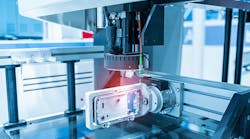Deciding how to measure length or distance in an automation environment can involve a confusing number of different sensing methods and devices to produce a result that meets the range, resolution, precision and repeatability specs required by the process.
We tend to first think of linear measurement as tape-measure-worthy dimensions, but, in reality, some of the dimensions we are concerned with are less than a micron, especially when talking about plating thicknesses, etchings in semiconductor dies or tolerances of mating parts of assemblies. A few transducer types are worthy of mentioning.
Also read: These 3 linear measurement techniques go the distance
Linear potentiometer
One of the oldest methods of generating an electrical length signal is using a linear resistor with a movable wiper that forms a linear potentiometer. These cheaply and effectively produce a voltage scaled to the length measured. The potentiometer requires no external electronics to produce a usable signal, but it can be subject to electrical noise and contamination since, depending on the design of the sensor, the resistive element can be somewhat open to dust and contaminants in the air.
Draw wire
Think of a draw wire as a rotary potentiometer or encoder attached to a spool of wire or flat band of metal with a spring rewind mechanism. The encoder or multi-turn potentiometer is turned by either the spool or by the passing wire, producing a signal proportional to length unwound from the spool. It is a simple, robust solution for linear variable differential transformer (LVDT) or linear variable inductance transducer (LVIT).
Higher in precision, resolution, repeatability and environmental effects, LVDTs and LVITs represent some of the highest standards for measurement. Units are available in 1-meter lengths for gantry or slide distance detection and in smaller, spring-loaded units for surface contact measurement with sub-micron resolution.
Rotary absolute encoder
With the advent of servo drives and motors in the 1980s and 1990s, it was possible to get extremely high precision position measurement from the motor that was doing the positioning via its attached position feedback encoder. Unfortunately, the motor had to find its home position after power-up before it could process a command to a new position. Each power cycle required another home position move. Eventually, absolute encoders became an option to drives, which did not require a home move on power-up, so a valid position could be read immediately, which was a vast improvement in most applications. The absolute encoder then found a home on its own without the attached servo drive, for measurement of various gantries or slides. The great thing about absolute encoders is the high precision, repeatability and noise rejection, not to mention that the measurement can be held through a power cycle.
Linear absolute encoder
Whereas rotary encoders are round, a linear encoder can be thought of as taking this round device, splitting one side, and laying it out flat into a slide-looking device. They offer the same high-resolution accuracy and repeatability of a rotary encoder, but require no gearing, and associated slop, to translate from a round device into a one-dimensional measurement. Linear encoders can give direct unit measurements to a slide or gantry or stand-alone measurement assembly.
Ultrasonic
I was introduced to ultrasonic length measurement when the first non-contact tape measures were introduced back in the 1990s. They were great for measuring rooms since they were made for pointing at flat walls in a room. Placing the back of the handheld device against one wall, pointing it at the opposing wall and pushing a button resulted in an inaudible ultrasonic wave coming from a small horn on the device and bouncing off the opposing wall and returning to the device. The amount of turnaround time is calculated, and a distance is calculated.
Industrial-grade ultrasonic transducers use the same principle, using a target of some sort to reflect the sound to the transceiver. Resolution is not awesome, but it serves an important niche for inexpensive measurement in environments where noise or dust can be a problem for other methods. Think lumber ripping or tubing/pipe cutting operations.
Laser
Laser uses a similar principle to ultrasonic, basically calculating the time it takes for a beam of LED light to bounce off a target and return to the transducer. The transducer’s lens must be kept clean, but the resolution and accuracy is much better than with ultrasonic, and, like ultrasonic, being a non-contact method, it can measure in places where it is unfeasible to use a slide or probe to calculate distance.
Vision system
Vision systems are becoming more prevalent on machines, especially sorting, assembly and packaging where visual quality control is incorporated or orientation of parts is checked before being picked by an industrial robot. By simply calibrating the image to a standard-length measure in both axes, a very accurate and possibly free method of measuring ware is possible in two dimensions at once.






